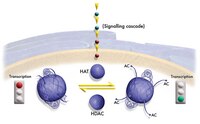12-357 Sigma-AldrichHistone H3 Peptide
This gene contains introns & its mRNA is polyadenylated, unlike most histone genes. The protein encoded is a replication-independent member of the histone H3 family.
More>> This gene contains introns & its mRNA is polyadenylated, unlike most histone genes. The protein encoded is a replication-independent member of the histone H3 family. Less<<Recommended Products
Overview
| Replacement Information |
|---|
Key Specifications Table
| Key Applications | Entrez Gene Number | Uni Prot Number |
|---|---|---|
| Enzyme Assays | NM_002107.3 | Q16695 |
| Description | |
|---|---|
| Catalogue Number | 12-357 |
| Brand Family | Upstate |
| Trade Name |
|
| Description | Histone H3 Peptide |
| References |
|---|
| Product Information | |
|---|---|
| Presentation | Lyophilized powder |
| Quality Level | MQ100 |
| Physicochemical Information |
|---|
| Dimensions |
|---|
| Materials Information |
|---|
| Toxicological Information |
|---|
| Safety Information according to GHS |
|---|
| Safety Information |
|---|
| Storage and Shipping Information | |
|---|---|
| Storage Conditions | 2 years at -20°C |
| Packaging Information | |
|---|---|
| Material Size | 100 µg |
| Transport Information |
|---|
| Supplemental Information |
|---|
| Specifications |
|---|
| Global Trade Item Number | |
|---|---|
| Catalog Number | GTIN |
| 12-357 | 04053252362101 |
Documentation
Histone H3 Peptide SDS
| Title |
|---|
Histone H3 Peptide Certificates of Analysis
| Title | Lot Number |
|---|---|
| Histone H3 Peptide (residues 1-20) - 2352348 | 2352348 |
| Histone H3 Peptide (residues 1-20) - 2376675 | 2376675 |
| Histone H3 Peptide (residues 1-20) | 3079177 |
| Histone H3 Peptide - 2450011 | 2450011 |
| Histone H3 Peptide - 18691 | 18691 |
| Histone H3 Peptide - 2021776 | 2021776 |
| Histone H3 Peptide - 22542 | 22542 |
| Histone H3 Peptide - 24998 | 24998 |
| Histone H3 Peptide - 2943600 | 2943600 |
| Histone H3 Peptide - 32623 | 32623 |
References
| Reference overview | Pub Med ID |
|---|---|
| Effects of a novel arginine methyltransferase inhibitor on T-helper cell cytokine production. Bonham, K; Hemmers, S; Lim, YH; Hill, DM; Finn, MG; Mowen, KA The FEBS journal 277 2096-108 2010 Show Abstract Full Text Article | 20345902
 |
















